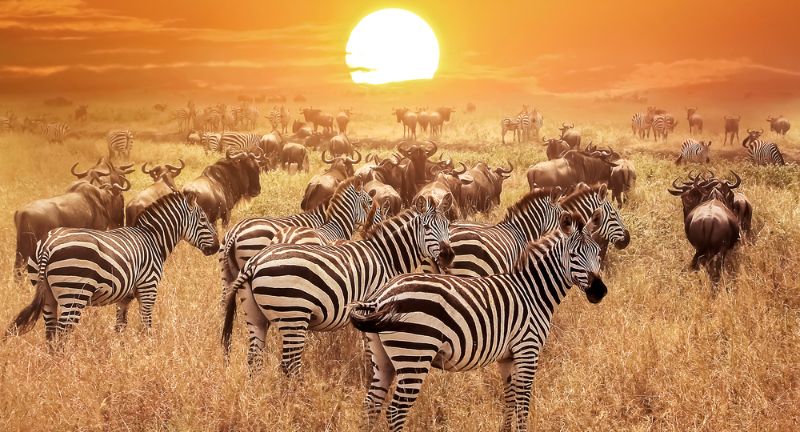ANIMALS
24 Wildlife Conservation Sanctuaries Around The World
Published
5 months agoon

Shutterstock
Wildlife conservation sanctuaries are vital in preserving biodiversity and protecting endangered species around the world. These sanctuaries provide safe havens for animals, often working on habitat restoration, species recovery programs, and sustainable eco-tourism. From tropical rainforests to arid deserts, each sanctuary plays a unique role in maintaining the delicate balance of its ecosystem. These protected areas are not just a refuge for wildlife but also a source of inspiration and education for visitors. In this guide, we explore 25 of the most important wildlife conservation sanctuaries across the globe, each contributing to the future of our planet’s biodiversity.
Yellowstone National Park, USA

Shutterstock
Yellowstone is the first national park in the world, established in 1872. It is famous for its geothermal features like Old Faithful and its rich wildlife, including grizzly bears, bison, wolves, and elk. The park plays a vital role in species reintroduction programs, including the successful return of the gray wolf in 1995. This 2.2 million-acre sanctuary is a cornerstone of conservation, protecting an entire ecosystem and fostering biodiversity.
Galápagos National Park, Ecuador

Shutterstock
The Galápagos Islands, famously studied by Charles Darwin, host species that are found nowhere else on Earth, such as the Galápagos tortoise and marine iguana. This UNESCO World Heritage site is an important conservation area, with strict regulations to protect its unique biodiversity from invasive species and over-tourism. Scientists and conservationists work year-round to ensure the survival of these species, many of which have evolved in isolation. Conservation efforts in the Galápagos set a global example of how to balance tourism and wildlife protection.
Kruger National Park, South Africa

Shutterstock
Kruger National Park is one of Africa’s largest game reserves, covering nearly 20,000 square kilometers. It is home to the Big Five—lion, leopard, elephant, rhino, and buffalo—and plays a crucial role in anti-poaching efforts, particularly for rhinos. The park is also a hub for biodiversity research, focusing on the preservation of endangered species. Kruger is a symbol of South Africa’s commitment to wildlife conservation and eco-tourism.
Serengeti National Park, Tanzania

Shutterstock
Serengeti National Park is best known for the Great Migration, where millions of wildebeest, zebras, and gazelles move across the plains in search of food. This incredible event supports a diverse predator population, including lions, cheetahs, and hyenas. Conservation efforts here focus on maintaining the delicate balance of this ecosystem while managing human-wildlife conflicts. Serengeti’s wide-open landscapes are vital for the survival of large migratory herds, making it one of Africa’s most iconic conservation areas.
Sundarbans National Park, India/Bangladesh

Shutterstock
The Sundarbans is the largest tidal halophytic mangrove forest in the world, located on the border of India and Bangladesh. It is a UNESCO World Heritage site and provides critical habitat for the endangered Bengal tiger, as well as saltwater crocodiles and a variety of bird species. Conservation efforts focus on protecting the mangroves, which are crucial for both wildlife and local communities that depend on fishing. The park is also vital in shielding coastal areas from cyclones and storm surges.
Corcovado National Park, Costa Rica

Shutterstock
Corcovado National Park is one of the most biodiverse regions in the world, protecting rainforests, mangroves, and coastal ecosystems. It is home to species like jaguars, tapirs, and scarlet macaws, making it a critical area for wildlife conservation in Central America. Conservationists work to protect this pristine environment from illegal logging and poaching, while eco-tourism helps fund these efforts. Corcovado’s untouched wilderness is a haven for both researchers and adventurers seeking to explore Costa Rica’s natural beauty.
Great Barrier Reef Marine Park, Australia

Shutterstock
The Great Barrier Reef is the world’s largest coral reef system, stretching over 2,300 kilometers. It supports a vast array of marine life, including over 1,500 species of fish, 400 types of coral, and endangered species like the dugong. The reef is under threat from climate change, particularly coral bleaching, making conservation efforts vital. Organizations and governments are working to protect this natural wonder through marine protected areas, restoration projects, and sustainable tourism practices.
Virunga National Park, Democratic Republic of Congo

Shutterstock
Virunga National Park is Africa’s oldest national park and a UNESCO World Heritage site. It is famous for its mountain gorilla population and has been at the forefront of conservation efforts in the region. Despite political instability and threats from poaching, Virunga’s rangers continue to protect its rich biodiversity, which includes elephants, lions, and over 700 bird species. The park also focuses on community-based conservation, involving local populations in efforts to protect wildlife and restore ecosystems.
Monarch Butterfly Biosphere Reserve, Mexico

Shutterstock
Located in the mountains of central Mexico, the Monarch Butterfly Biosphere Reserve is a critical habitat for millions of migrating monarch butterflies. These butterflies travel over 3,000 miles from Canada and the U.S. to overwinter in this forested sanctuary. The reserve is a UNESCO World Heritage site and plays a crucial role in the conservation of this species, which faces threats from habitat loss and climate change. Conservation efforts focus on protecting the fir forests and raising awareness of the monarch’s ecological importance.
Masai Mara National Reserve, Kenya

Shutterstock
The Masai Mara is one of the most famous conservation areas in Africa, renowned for its annual wildebeest migration. It also provides habitat for iconic species such as lions, cheetahs, and elephants. Conservation efforts in the Mara focus on balancing wildlife protection with the needs of local Maasai communities, who rely on livestock grazing. The reserve is a model for community-based conservation, ensuring that both people and wildlife can coexist harmoniously.
Everglades National Park, USA

Shutterstock
The Everglades is the largest subtropical wilderness in the United States, covering 1.5 million acres. It provides crucial habitat for rare species like the Florida panther, American crocodile, and West Indian manatee. Conservation efforts focus on water management to restore the natural flow of this ecosystem, which has been altered by human activity. The park is a UNESCO World Heritage site and is key to protecting both wildlife and the water supply of southern Florida.
Pantanal Conservation Area, Brazil

Shutterstock
The Pantanal is the world’s largest tropical wetland, spanning parts of Brazil, Bolivia, and Paraguay. It supports an incredible array of wildlife, including jaguars, capybaras, giant river otters, and over 650 bird species. Conservation efforts in the Pantanal focus on protecting its biodiversity from threats like deforestation, agriculture, and wildfires. The area is also vital for water regulation and carbon storage, making it critical for both wildlife and climate resilience.
Yala National Park, Sri Lanka

Shutterstock
Yala National Park is one of Sri Lanka’s premier wildlife sanctuaries, known for its large population of leopards. In addition to leopards, Yala is home to elephants, sloth bears, and numerous bird species. Conservation efforts here focus on anti-poaching, habitat protection, and wildlife tourism management. Yala is a crucial area for biodiversity in Sri Lanka, offering a refuge for some of the island’s most endangered species.
Gorongosa National Park, Mozambique

Shutterstock
Once devastated by civil war, Gorongosa National Park is now one of Africa’s most remarkable conservation success stories. Through intensive restoration projects, species such as elephants, hippos, and lions are rebounding. The park also focuses on community-based conservation, working with local residents to protect wildlife while improving livelihoods. Gorongosa’s recovery showcases the power of collaboration between conservationists, scientists, and local communities.
Plitvice Lakes National Park, Croatia

Shutterstock
Plitvice Lakes National Park is a UNESCO World Heritage site, famous for its chain of 16 terraced lakes and waterfalls. It is home to large mammals like brown bears, wolves, and lynxes, as well as rare bird species. Conservation efforts focus on preserving the park’s pristine water quality and protecting its forests and wildlife from the pressures of tourism. Plitvice is a shining example of natural beauty and the importance of preserving delicate ecosystems.
Kakadu National Park, Australia

Shutterstock
Kakadu is one of Australia’s largest national parks, known for its stunning biodiversity and rich Aboriginal heritage. The park is home to saltwater crocodiles, wallabies, and hundreds of bird species. Conservation efforts here include fire management to protect ecosystems from uncontrolled bushfires and the control of invasive species. Kakadu is a vital area for both wildlife conservation and cultural preservation, making it a key destination for eco-tourism.
Ranthambore National Park, India

Shutterstock
Ranthambore is one of the best places in India to see wild Bengal tigers in their natural habitat. The park also supports leopards, wild boars, and a variety of birds. Conservation efforts focus on anti-poaching patrols and habitat restoration to ensure the long-term survival of the tiger population. Ranthambore’s blend of history, wildlife, and scenic beauty make it a must-visit for conservation enthusiasts.
Fiordland National Park, New Zealand

Shutterstock
Fiordland National Park is famous for its dramatic fjords, including Milford Sound, and its role in protecting New Zealand’s unique bird species like the kiwi and endangered takahe. Conservation efforts focus on controlling invasive species that threaten native wildlife and maintaining the park’s pristine landscapes. The park is a UNESCO World Heritage site and plays a crucial role in preserving New Zealand’s natural heritage. Fiordland offers breathtaking scenery and a chance to experience one of the world’s last untouched wildernesses.
Sossusvlei, Namibia

Shutterstock
Sossusvlei is located in the heart of the Namib Desert and is known for its towering red sand dunes. The area supports desert-adapted wildlife, including oryx, springbok, and cheetahs. Conservation efforts here focus on sustainable tourism and preserving the fragile desert ecosystem. Sossusvlei’s striking landscapes and unique wildlife make it one of Namibia’s most iconic conservation areas.
Taman Negara National Park, Malaysia

Shutterstock
Taman Negara is one of the oldest rainforests in the world, estimated to be over 130 million years old. The park is home to a wide variety of wildlife, including the Malayan tiger, Asian elephant, and Malayan tapir. Conservation efforts focus on protecting these endangered species from poaching and deforestation. Taman Negara offers visitors a glimpse into one of the most ancient and biodiverse ecosystems on the planet.
Bwindi Impenetrable National Park, Uganda

Shutterstock
Bwindi is home to more than half of the world’s remaining mountain gorillas and is a UNESCO World Heritage site. The park’s conservation efforts focus on protecting these critically endangered primates and their forest habitat. Gorilla trekking in Bwindi is a major driver of eco-tourism, with visitor fees supporting ongoing conservation projects. Bwindi’s dense forests are also home to hundreds of bird species, making it a biodiversity hotspot in Africa.
Zhangjiajie National Forest Park, China

Shutterstock
Zhangjiajie National Forest Park is famous for its towering sandstone pillars, which inspired the floating mountains in the movie *Avatar*. The park is home to endangered species like the Chinese giant salamander and various macaques. Conservation efforts focus on maintaining the park’s natural beauty while promoting sustainable tourism. Zhangjiajie is a UNESCO Global Geopark, drawing visitors for its breathtaking landscapes and diverse wildlife.
Rwanda’s Volcanoes National Park

Shutterstock
Volcanoes National Park in Rwanda is best known for being one of the last strongholds of the critically endangered mountain gorilla. Conservation efforts here focus on protecting gorillas from poaching and habitat loss, with gorilla trekking providing vital funding for these projects. The park is part of the Virunga volcanic mountains and also houses golden monkeys and diverse bird species. Volcanoes National Park is a model for eco-tourism, balancing wildlife conservation with local community benefits.
Isle Royale National Park, USA

Shutterstock
Isle Royale National Park is a remote wilderness in Lake Superior, known for its long-term study of the predator-prey relationship between wolves and moose. The park’s isolation creates a unique environment for research on ecosystem dynamics and species interaction. Conservation efforts focus on maintaining the balance between these populations and addressing threats like inbreeding among wolves. Isle Royale is a designated wilderness area, offering visitors a chance to experience pristine natural beauty and participate in conservation research.
Chitwan National Park, Nepal

Shutterstock
Chitwan National Park is Nepal’s first national park and a UNESCO World Heritage site, renowned for its successful efforts in conserving the endangered one-horned rhinoceros. The park is also home to Bengal tigers, leopards, and Gharial crocodiles. Conservation initiatives focus on anti-poaching patrols and habitat restoration, which have led to a significant increase in rhino and tiger populations. Chitwan’s diverse ecosystems, ranging from grasslands to forests, make it a key conservation area in South Asia.
Conclusion

Shutterstock
Wildlife conservation sanctuaries play a critical role in preserving our planet’s natural heritage for future generations. These protected areas not only safeguard endangered species and ecosystems but also offer hope for the recovery of wildlife populations under threat. Through ongoing conservation efforts, collaboration with local communities, and eco-tourism, these sanctuaries continue to make significant contributions to global biodiversity. Visiting and supporting these sanctuaries allows individuals to directly participate in the preservation of the Earth’s incredible wildlife. As we move forward, the importance of these sanctuaries will only grow in the fight against climate change and habitat destruction.
More Amazing Animals+
-


30 Most Beautiful Animals on the Planet
-
15 Fun Facts About Americas Favorite Baby Hippo – Moo…
-


29 Myths About Penguins That Just Aren’t True
-


Kibble Goes Refillable: Pet Food Company Cracks Down On Waste…
-


The Bearded Dragon: A Surprising Guide to Your New Favorite…
-


28 Creatures That Thrive in Extreme Temperatures
-


Mama bird feeding her babies in their traffic light nest…
-


Cranes Are More Interesting Then You May Think, Here Is…
-


A Woman Recieves a Surprise Gift in the Air After…
-


From Hopping to Boxing: 25 Incredible Facts About Kangaroos
-


Don’t Let This Bird Fool You
-


Orphaned bear cubs playing in tree after mother bear, Bobbi,…
